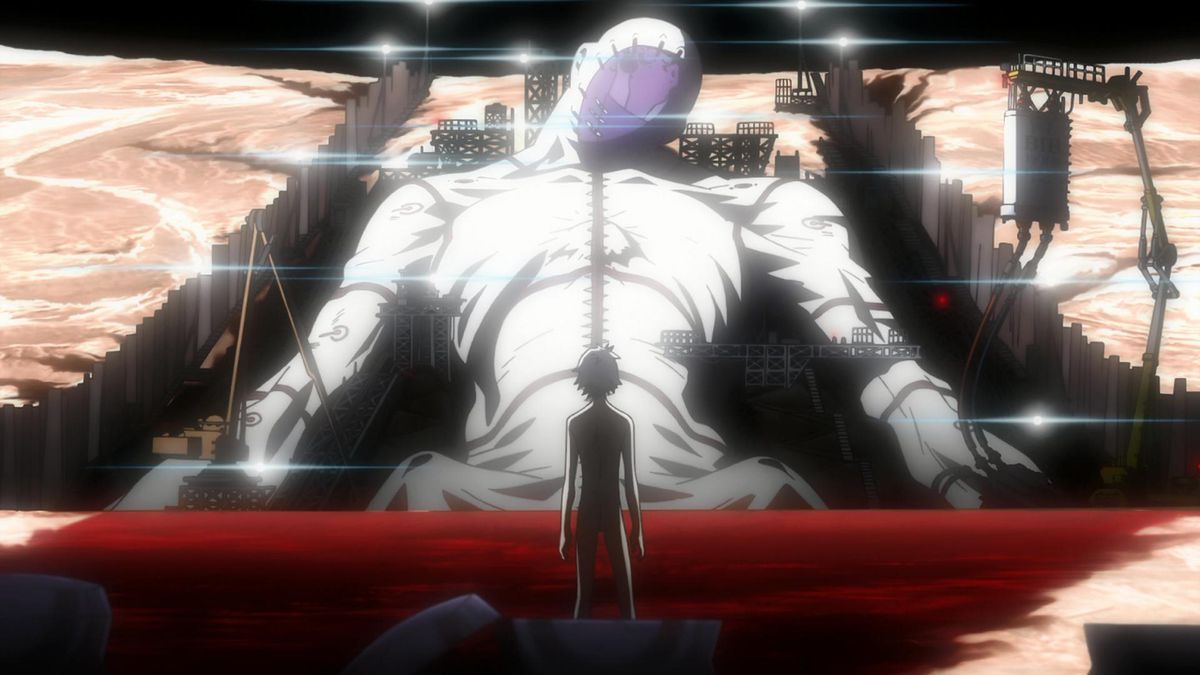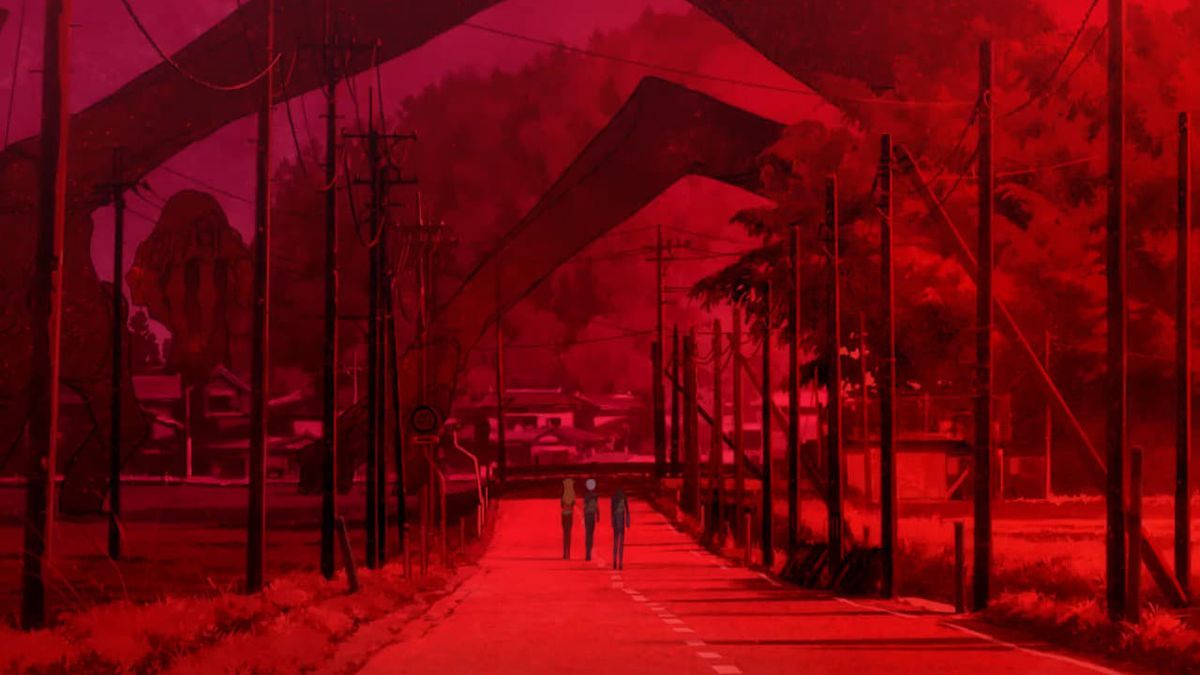Nearly two years after Netflix brought the legendary anime series Neon Genesis Evangelion series to the platform, Amazon Prime Video has released Evangelion 3.0+1.0: Thrice Upon a Time, the final installment of creator Hideaki Anno’s four-movie “remake.” With a combined production time spanning nearly two decades, the Rebuild of Evangelion films were conceived to introduce the franchise to a whole new generation of audiences who had not seen the original 1995 anime. But as Evangelion 3.0+1.0 has shown, Anno failed in his mission to produce a condensed, standalone series. Despite existing in a separate continuity and diverging heavily from the events of the original Neon Genesis Evangelion, the Rebuild films are inextricably bound to the original, making an experience separate and apart from it nearly impossible. And the movies are better for it.
The 1995 anime series Neon Genesis Evangelion took place in an alternate 2015 where, following a global apocalyptic event known as the Second Impact that decimated two thirds of the human population, the remnants of human civilization are besieged by an existential threat in the form of otherworldly entities known as “Angels.” 14-year-old Ikari Shinji, the estranged son of the commander of a Japanese paramilitary organization known as NERV, alongside his cohorts Soryu Asuka Langley and Ayanami Rei is tasked with piloting a trio of colossal biomechanical weapons known as Evangelion, or “Evas,” in order to combat the Angels in the fortified futuristic city of Tokyo-3.
The plot drills down into ever more headier, dare I say, impressionistic interpretations of Judeo-Christian apocrypha as the show progresses, name dropping everything from the Dead Sea Scrolls and the Spear of Longinus to the biblical figures of Adam and Lilith. All of which exists in the series with no deeper allegorical intent than for the fact that it just seemed cool at the time to incorporate during the anime’s production, as Neon Genesis Evangelion assistant director and Rebuild co-director Kazuya Tsurumaki so candidly stated in a 2002 Otakon Q&A panel.

Image: Studio Khara
In 2006, Toshmichi Otsuki, one of the executive producers for Evangelion: 1.0 You Are (Not) Alone, Evangelion: 2.0 You Can (Not) Advance, and Evangelion: 3.0 You Can (Not) Redo, told NewType USA what both fans of the original series and newcomers could expect from the then-announced film series. “It’ll be something viewers can enjoy if they’ve never seen the TV series,” said Otsuki, “I want everyone — from hardcore fans of the original work to people who only know it because of the licensed stuff — to look at it as a standalone film series.” At the time, Otsuki specifically cited the show’s affinity for esoteric jargon and “filling works with difficult words and concepts” as one pain point the remakes would directly address.
The interview is especially amusing after watching the Rebuild films and Evangelion: 3.0+1.0. Inexplicable plot elements and proper noun concepts such as the “Gate of Gulf,” the “Key of Solomon,” “L-C Fields,” “Evangelion Imaginary,” “Corization,” and “L Barriers” are all breathlessly shouted amid sequences of intense explosive destruction, as if to imbue the action on-screen with some semblance of dramatic heft and thematic importance. Try though the producers of the Rebuild films might, these nonsensically esoteric elements are part of what make Evangelion, well, Evangelion and represent a necessary threshold through which any potential fan of the series must at one point or another face and move past.
Don’t believe anyone, longtime Evangelion fan or not, who tells you that they understand this shit. They don’t, and that’s entirely the point. For as much as Neon Genesis Evangelion’s visual identity centers around its invocation of esoteric archetypal Christian imagery, much of that imagery existed with no justification other than through the literal Rule of Cool.
As Siddhant Adlakha mentions in his review of Evangelion 3.0+1.0 for Polygon, “The series has always laid its track directly in front of the train, but the logistics behind, for instance, some glowing crucifix or holy lance popping into existence are hardly the most important parts of the saga. The sudden injection of these things into a given scene is usually a function of Gendo being 10 steps ahead of anyone else, as the heroes at WILLE struggle to wrap their minds around literally hellish concepts just to keep pace.”

Image: Studio Khara
No matter how radically Hideaki Anno diverged from the 1995 series in his Rebuild films, Evangelion as a franchise never escaped itself, and as such, the original 25-episode anime and the 1997 film remain essential in understanding the Rebuild films. Even the subtitle of the final film, Thrice Upon a Time, seems to allude to this fact; breaking from the parentheses-laden precedent of the prior three installments while gesturing that it itself represents the third time that Hideaki Anno has attempted to end the series to date. Despite this failure to create a work that exists separate from the original series, Evangelion 3.0+1.0 delivers something by dint of this association that neither the original anime nor 1997’s End of Evangelion was capable of: a definitive conclusion; one more hopeful, affirming, beautiful, and explicit in its resolution than any previous ending of the series before it.
Without spoiling anything, both the end of Neon Genesis Evangelion and End of Evangelion find Shinji confronting his fear of being hurt by others, and embracing the fact that love and happiness are possible in spite of that fear — but it’s all couched in bizarre horrific apocalyptic imagery that sorta deafens that sense of happiness. Those tonally bleaker endings aren’t rendered moot by Evangelion 3.0+1.0; in fact, those events happened and mattered to the Shinji of a different timeline. Without a knowledge of those events, the full magnitude of the character’s revelation at the end of 3.0+1.0 — and Anno’s decision to render the finale with stillness and sunshine — would be lost.
”Eva” is a story that repeats,” Anno wrote in a statement released on the Evangelion website in February 2007, just seven months prior to the release of Evangelion: 1.0 You Are (Not) Alone. “It is a story where the main character witnesses many horrors with his own eyes, but still tries to stand up again. It is a story of will; a story of moving forward, if only just a little. It is a story of fear, where someone who must face indefinite solitude fears reaching out to others, but still wants to try.”
In concluding the Rebuild of Evangelion tetralogy, Anno and Studio Khara have pushed the franchise farther ahead than it has ever gone before. Evangelion 3.0+1.0’s ending could not have existed were it not for the original anime and End of Evangelion, and as such, they are as essential in understanding and enjoying the Rebuild’s story as the Rebuild films themselves.
Polygon – All
Source link
Related Post:
- The Evangelion: 3.0+1.0 ending and Rebuild series meaning, explained
- Rebuild of Evangelion Dub Languages Teased in New Trailer
- Evangelion and Conan Movies Raised Toho Earnings By 3000%
- 6 best underrated anime series you should be watching right now
- WoW Is Changing To ‘Rebuild Trust,’ Blizzard Says Amid Lawsuit
- What’s a game you like to play while doing or watching something else?
- Enjoy watching Hearthstone players, casters react with horror at this three-turn lethal
- You can get a Diablo 2: Resurrected beta key by watching Twitch streams right now
- Reclaiming the Middle-earth from before the movies • Eurogamer.net
- 10 best movies to watch before The Matrix 4 on Netflix, HBO Max and more
